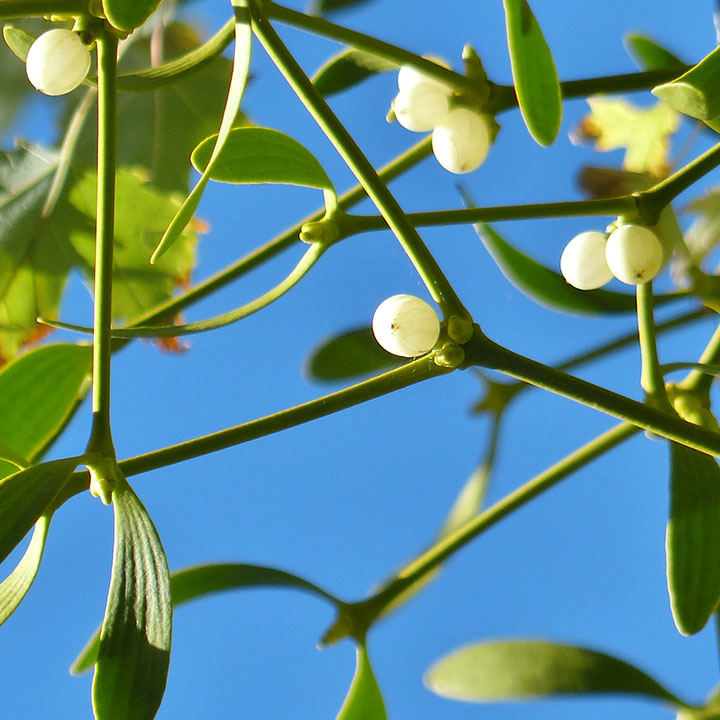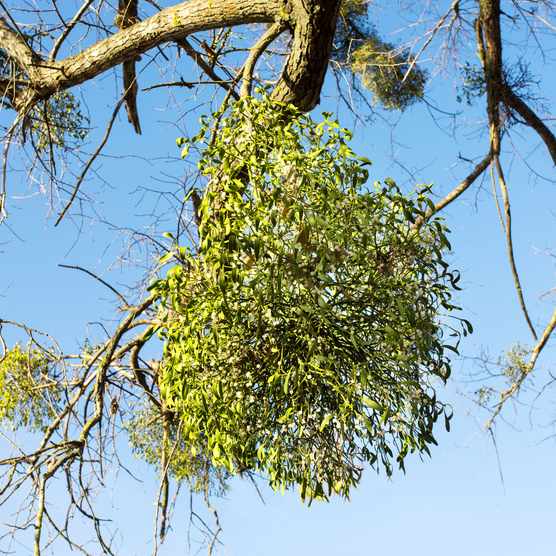
Mistletoe, like holly and ivy, is part of the festive décor associated with a traditional northern hemisphere holiday season, most notably the custom of kissing when standing under it. However, this plant has more to it than holiday affection. It has a long history of being part of pagan winter customs and rituals as well as featuring in Norse mythology, but the reality of its nature and role in a thriving ecosystem is what really makes this a fascinating and remarkable plant.
The mistletoe of Christmas traditions (Viscum album) hails from Europe and has been used since pagan times to decorate homes as part of winter solstice ceremonies when it was deemed to ward off evil. It was also considered a sacred plant by Celtic druids not only able to ward off evil but also cure illnesses and increase fertility. The custom of kissing under the mistletoe stems in part from Norse mythology. Baldur was the beloved son of Odin and Frigg and when it was foretold that Baldur would die, Frigg requested all living things not to harm her son. However, she overlooked the mistletoe plant deeming it too small to be a threat. Baldur was unable to be harmed by any weapons until Loki, realizing mistletoe was not included in the promise to Frigg, gave blind Hodr a spear made of mistletoe to throw at Baldur. Instead of bouncing off him harmlessly it killed him. Frigg sent a messenger to afterworld to plead for Baldur’s return and the wish was granted provided all living things wept for Baldur. All wept except one giantess, Loki in disguise, and Baldur was condemned to remain among the dead.
It is then said that Frigg designated the mistletoe plant as one of friendship and kindness and should people happen to meet under some mistletoe they should embrace and kiss. While there is little evidence to confirm this is the origin of mistletoe’s modern role, it appears that by the 18th century the custom was taking hold in Britian. It became firmly established in the 19th century when ladies caught standing under the mistletoe were expected to offer a kiss or risk bad luck, and for each kiss given a berry would be removed from the mistletoe resulting in no more kissing when all berries were gone!

Mistletoe is a parasitic plant, although most of the species are what is known as hemi-parasitic, which means it does not rely on its host plant for all its nutrients. Mistletoe varieties with green stems and leaves can photosynthesis, but not sufficiently to meet all their needs. The dwarf mistletoes, which are red in color, do not photosynthesis as they contain no chlorophyl. Like all seeds, mistletoe berries contain enough stored energy to enable the germinating seed to start growing. Mistletoe berries initially grow a hypocotyl, a form of modified stem, which in turn produces a haustorium, a type of root that penetrates the bark of the host tree and from that point mistletoe draws some, if not all its nutrients from the host plant. All parts of the plant are toxic, although birds and animals are able to consume the berries, and this is one of the means mistletoe employs to disperse its seeds. The seeds are sticky, so even if birds do not eat the berries the seeds can hitch a ride on other tree dwelling creatures.
However, some varieties of mistletoe, such as the dwarf mistletoe native to southwestern U.S.A., have explosive berries which enable the seeds to be shot up to twenty feet away. Of the 1300 plus species of mistletoe worldwide, 30 are native to the continental U.S. and 6 are native to Hawaii. European mistletoe has been introduced to California, but the mistletoe sold in stores will be a native equivalent, Phoradendron serotinum, which can be found growing in a line south from New Jersey to Oregon. Dwarf mistletoes have a wider range, being found in Canada and Alaska all the way down to California.
Although mistletoe is parasitic, it is rare that its presence kills its host. Occasionally the weight of the mistletoe plant might break a branch, but some of the dwarf mistletoes, whose preferred hosts are conifers, can weaken their hosts to the point that they cannot fend off additional attacks from insects or disease. While mistletoe is not welcome in commercial timber forests, it does have benefits for wildlife. Not only do many species of birds rely on mistletoe’s berries as a source of food, but so do a number of mammals, and research has recorded that the number and species of wildlife are higher in forests that contain mistletoe than those that don’t. Mistletoe berries are rich in proteins, fats and other nutrients, as well as being a valuable source of water in arid locations. In addition, the witches’ brooms that are mistletoe’s branch structures make perfect nest sites for certain animals and birds, as well as the cavities that develop in some trees as a result of mistletoe growth.
Mistletoe also benefits insect life and there are three species of butterfly that are totally dependent on mistletoe as a food source. They are great purple hairstreak, thicket hairstreak and Johnson’s hairstreak. It also benefits other insects as mistletoe flowers early in the spring and therefore is an important nectar and pollen source for bees and other insect pollinators.
So, while mistletoe is unwelcome in commercial forests, for the past twenty thousand years it has been an integral part of woodlands worldwide, a part of the symbiotic relationship between living things and is doubly welcome as it also makes the holidays festive!
Sources: 12 Things to Know about Mistletoe • The National Wildlife Federation Blog (nwf.org)
Not Just for Kissing: Mistletoe and Birds, Bees, and Other Beasts | U.S. Geological Survey (usgs.gov)







